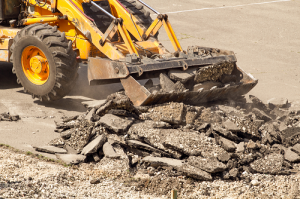Every day, many houses, shops, restaurants, and infrastructure are constructed as the construction boom continues. However, despite the debris or waste, we are also building something else, which is a giant pile of waste. It is mainly because there are large wood, concrete, brick, and beyond, and it extremely difficult to curb the buildups. Undoubtedly, it is impossible to recycle every waste of debris, but much it is possible to eliminate recycling. It is merely difficult for builders to manage waste with efficiency. Construction materials are wider in a range that depends on the project, and these include –
- Bricks, and masonry
- Concrete
- Wood
- Metal that includes piping
- Drywall and plaster
- Glass and windows
- Debris from large projects
- Landscape waste
However, the recycling of construction materials leaves a huge impact –
- This help conserve finite resources
- These have the potential to create economic impact with the reprocessed or salvaged materials
- These prevent the increased use of landfills
- These also reduce the freight charges
- These maximize the lifespan of the materials
- When the recycled materials are used, the cost gets reduced.
 Here are some of the facts related to construction and demolition for which you need to be aware of –
Here are some of the facts related to construction and demolition for which you need to be aware of –
Fact 1 – According to the Construction & Demolition Recycling Association, with the recycling of around 538 million tons of C&D waste can save up to 4,300 acres of landfill space.
Fact 2 – The EPA report of 2016 shows that recycling construction waste has created around 2,30,000 jobs for the people.
Fact 3 – The debris materials are not only responsible for causing landfill and environmental concerns, but the buildings in the U.S. are also responsible for causing maximum emissions of CO2.
Fact 4 – Green design projects in commercial settings also created maximum revenue.
Fact 5 – According to the Federal Highway Agency, recycling the asphalt pavement is now possible.
Fact 6 – When you invest in the LEED certification, it pays off, due to which the developers are now making the use of the LEED process to build better buildings as it immediately impacts the performance of the buildings and bottom line.
Fact7 – The National Asphalt Pavement Association that works to recycle the asphalt effectively saves the taxpayers from paying much on the construction waste.
When you hire the construction waste collectors, you get the efficient, safe, and eco-friendly construction waste disposal services while helping you in completing your project with professionalism. The professionals make sure that the construction waste can get out of your way while efficiently handling the hauling services.
What can you do?
When it comes to recycling construction and demolition waste, most construction managers are not aware of where they can start, but doing so is mainly valuable. Landfill fees are increasing rapidly, due to which the customers are becoming more focused on sustainability, so when you choose to recycle, it costs you much more than you think. However, the better way to handle the construction and demolition waste is by sending it to landfills. However, here are some of the tips you can follow to get started –
- You can separate the materials in the different containers to increase the potential salvaging as the wood, concrete, masonry, and asphalt that can be recycled.
- You can recognize the potential to cut costs with valuable commodities such as steel, aluminum, copper, and brass.
- You can discover the tax breaks while attracting new customers with LEED certification and recognition.
- You can donate materials to non-profit organizations instead of dumping them in the waste.
Contact us for more information.
 Text Us
Text Us




 Traditionally people used to pile up their garbage to burn it off in the back yard, and that was the way most people use to get rid of the junk. However, in today’s world, various latest and advanced technologies work best to eliminate junk, so hiring a
Traditionally people used to pile up their garbage to burn it off in the back yard, and that was the way most people use to get rid of the junk. However, in today’s world, various latest and advanced technologies work best to eliminate junk, so hiring a  In California, construction and demolition debris includes:
In California, construction and demolition debris includes: There is some safety risk involved in handling leftover construction materials such as glass, iron,
There is some safety risk involved in handling leftover construction materials such as glass, iron,  Before we can start picking up your chemical waste, you’ll want to create a proper storage setup that accounts for the safety of everyone in your building. Here are the best practices you will need to follow:
Before we can start picking up your chemical waste, you’ll want to create a proper storage setup that accounts for the safety of everyone in your building. Here are the best practices you will need to follow: You already know that dead leaves, tree branches, and other plant life that’s collected or accumulated on your property qualifies as yard waste, but you may not know that many other materials you might throw away can also be disposed of responsibly.
You already know that dead leaves, tree branches, and other plant life that’s collected or accumulated on your property qualifies as yard waste, but you may not know that many other materials you might throw away can also be disposed of responsibly.  The truth is that many municipalities put limits on how much yard waste they’ll pick up, and yard waste itself can surprisingly cause a lot of issues for the environment when disposed of improperly.
The truth is that many municipalities put limits on how much yard waste they’ll pick up, and yard waste itself can surprisingly cause a lot of issues for the environment when disposed of improperly. It is important to establish criteria for sorting out the items in the house when providing hoarder help. Hoarding often leads to the retention of damaged, useless and unnecessary appliances, clothes, tools, mail and other similar materials. If the
It is important to establish criteria for sorting out the items in the house when providing hoarder help. Hoarding often leads to the retention of damaged, useless and unnecessary appliances, clothes, tools, mail and other similar materials. If the  Construction-related waste can be reduced before collection and disposal. Minimizing the materials will reduce the total costs of handling and disposing. In addition, reduced waste reduces the implications of the building work on the environment. If you are planning on demolishing a structure, consider deconstruction instead. Deconstruction involves the careful dismantling of a building. The resulting materials can be reused when rebuilding. If you do not want to use the materials in your structure, you can sell to interested parties.
Construction-related waste can be reduced before collection and disposal. Minimizing the materials will reduce the total costs of handling and disposing. In addition, reduced waste reduces the implications of the building work on the environment. If you are planning on demolishing a structure, consider deconstruction instead. Deconstruction involves the careful dismantling of a building. The resulting materials can be reused when rebuilding. If you do not want to use the materials in your structure, you can sell to interested parties. Clearing away piles of debris is no easy task. Here are five good reasons you should call Junk King and make it a stress-free chore.
Clearing away piles of debris is no easy task. Here are five good reasons you should call Junk King and make it a stress-free chore.